Country Indonesia Type Air Force | Allegiance President of Indonesia Founded 9 April 1946 | |
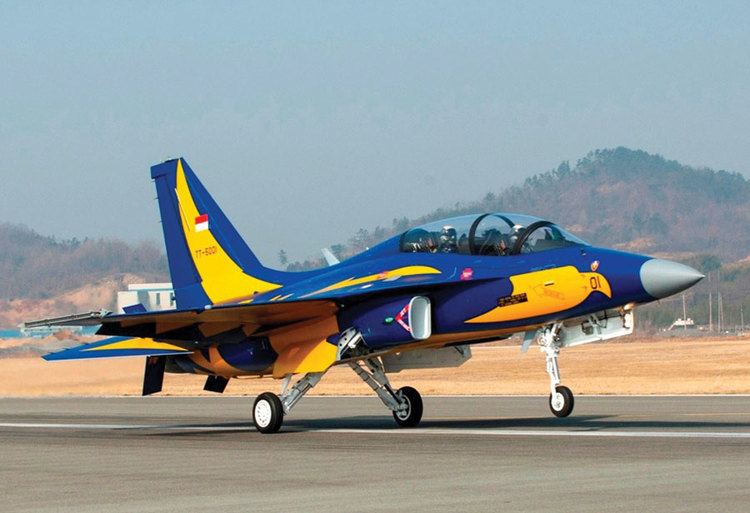 | ||
Role Defence and dominance of Indonesia's airspace and its territory Size 37,850 personnel
224 aircraft Motto(s) Swa Bhuwana Paksa
(Sanskrit, "Wings of the Motherland") Founder Indonesian National Armed Forces Fighters General Dynamics F-16 Fighting Falcon, Sukhoi Su-30MKK, Sukhoi Su-27 Transports Lockheed C-130 Hercules, CASA/IPTN CN-235 Engagements Operation Trikora, Indonesia–Malaysia confrontation, Indonesian invasion of East Timor, Papua conflict Trainers KAI KT-1 Woongbi, BAE Systems Hawk Similar Indonesian Army, Indonesian Navy, Paskhas, Indonesian Marine Corps, Royal Australian Air Force Profiles | ||
The Indonesian Air Force (Indonesian: Tentara Nasional Indonesia-Angkatan Udara, TNI–AU) is the air force branch of the Indonesian National Armed Forces.
Contents
- Before Indonesian independence 19411945
- Indonesian War of Independence Netherlands Police Action 19451949
- Action against rebellions 19501961
- Soviet influence 19621965
- 30 September movement and the overthrow of Sukarno 19661970
- Rebirth 19701980
- Influence of American and allied products 19801998
- Embargoes 19982006
- Minimum Essential Force MEF 2010present
- Special and Ground Forces
- Force structure
- Chief of the Air Staff
- Notable incidents
- Radars and missiles
- Unmanned aerial vehicle
- References
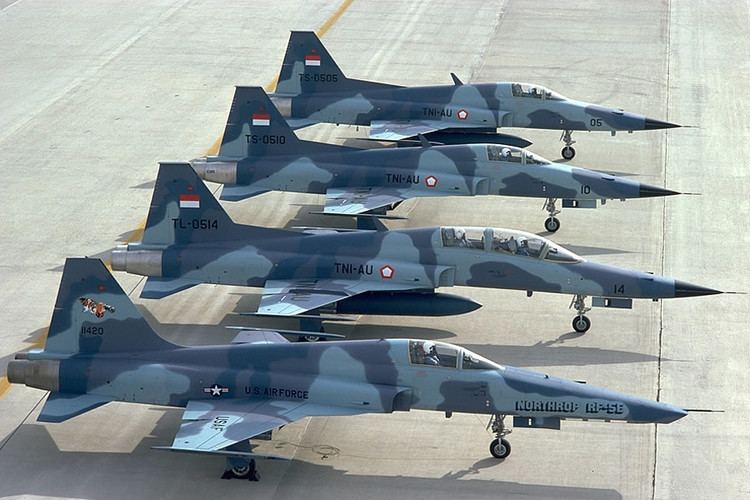
The Indonesian Air Force has 37,850 personnel and equipped with 110 combat aircraft. The inventory includes SU-27 and SU-30 as the main fighters (from Russia) supplemented by F-16 Fighting Falcons (from the USA). The Indonesian Air Force is also currently engaging in talks with Russia to purchase 8 Sukhoi SU-35 as a replacement for the already-aging US Northrop F-5 Tiger light fighters in its inventory.
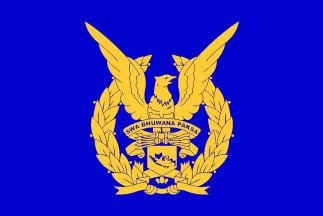
Before Indonesian independence (1941–1945)
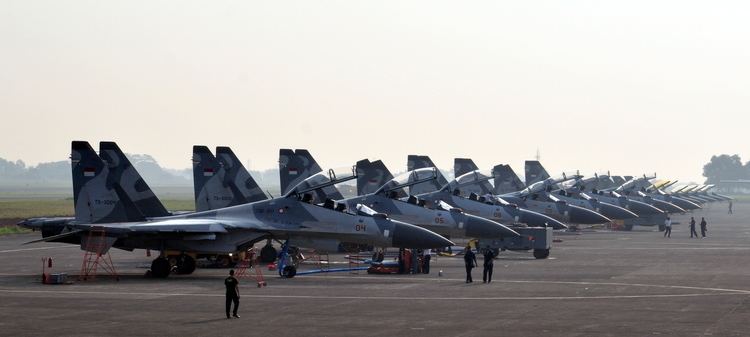
After World War II ended, Indonesia became the second country (after Thailand) in Southeast Asia to acquire an air force. Indonesian pilots fought against the colonial forces of the Netherlands during 1945–1949 with former Japanese aircraft abandoned at the end of World War II, as well as aircraft of the Netherlands East Indies Air Force (including Curtiss P-36 Hawk (P-36 Mohawk), Brewster F2A Buffalo and Fokker D.XXI fighters; Martin B-10 bombers; Fokker C.X reconnaissance floatplanes) left before the Japanese occupation in 1941.
Indonesian War of Independence / Netherlands 'Police Action' (1945–1949)
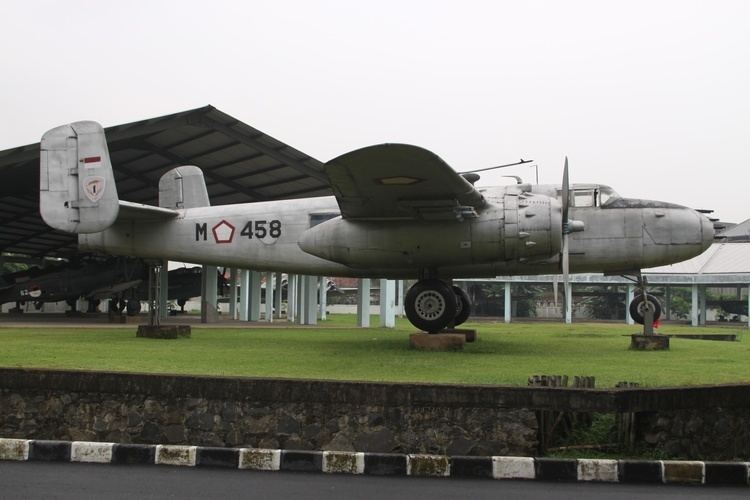
After the Japanese announced their surrender at the end of WWII, Indonesian nationalist leader Sukarno declared Indonesian Independence on 17 August 1945. Several days later, Indonesian People's Security Force (Badan Keamanan Rakyat) was formed to undertake security duties. The Air Division of this force was also formed, using ex-Japanese planes scattered everywhere, especially in the island of Java, including Bugis Air Base in Malang (Established on 18 September 1945). The most numerous of these aeroplanes were the Yokosuka K5Y1 Willow (Cureng) trainers, which were hastily used to train newly recruited cadets. At the time of the founding, there was only one Indonesian holding a multi-engine pilot license from the pre-war Dutch Flying School, Agustinus Adisucipto (but did not have an opportunity to fly during the 3.5-year Japanese occupation). He was assisted by a few Japanese pilots who decided to stay in the newly born country. The new roundel was created simply by painting white on the lower part of the Japanese Hinomaru, reflecting the red and white of the Indonesian flag. The People's Security Force was then re-organized to form a formal armed force. This marked the birth of the Indonesian Air Force on 9 April 1946. However, tensions rose as the Dutch tried to re-claim their former colony and launched an assault on 21 July 1947, destroying most of the planes on the ground. Some planes survived though and were hidden in remote bases.
29 July 1947 was date of the first air operation by the newborn air force as three surviving aircraft, comprising two Yokosuka K5Y1 Willow (Cureng) and a Mitsubishi Ki-51 Sonia (the fourth aircraft, a Nakajima Ki-43 Oscar (Hayabusa) flown by Air Cadet Bambang Saptoadji, should also have been involved in the raid as an escort, but as of when it was launched, the aircraft was not airworthy due to engine troubles) conducted air raids at dawn on the Dutch Army barracks in Semarang, Salatiga and Ambarawa, dropping incendiary bombs. Tactically, these raids did not have any effect on the Dutch positions, but psychologically, it was a great success as it proved that the Indonesian Air Force still existed. The Dutch had previously claimed the destruction of Indonesian Air Force in their assault before and they never expected any attack from the sky. Dutch Curtiss P-40E Warhawks tried to find all the guerrillas' planes, but they were too late to find those "ghost" aircraft which landed quickly in Maguwo Air Base, near Yogyakarta (now, Adisucipto International Airport). Indonesian pro-independence guerrillas tried to save captured aircraft in a number of remote areas, including examples of the Mitsubishi A6M Zero-Sen "Zeke", Aichi D3A "Val", and Mitsubishi G4M "Betty".
Under pressure from the United Nations, the Dutch finally agreed to acknowledge Indonesian independence. Following the 1949 Round Table Conference, sovereignty was officially transferred to the United States of Indonesia. The Dutch armed forces left (but remained in West Papua until 1963) and the aeroplanes were handed over to the Indonesians. These comprised, among others, North American P-51 Mustang, North American B-25 Mitchell, North American T-6 Texan, Douglas A-26 Invader, Douglas C-47 Dakota and Consolidated PBY-5A Catalina, which served as the main forces of the Indonesian Air Force for the following decade. During this era, Indonesia received its first jet aircraft; De Havilland DH-115 Vampire. It was also during this era that the national roundels were changed to the red and white pentagon (which was supposed to signify Indonesia's national ideology of "Panca Sila", or the "Five Principles", created by Sukarno in 1945).
Action against rebellions (1950–1961)
Political instability meant that the Indonesian Air Force saw action against several regional rebellions in Indonesia such as PRRI, Permesta, Darul Islam-Tentara Islam Indonesia (DI/TII) and the Republic of South Maluku separatists.
Several Indonesian pilots scored their first kills, including Captain Ignatius Dewanto with his North American P-51 Mustang, who in 1958 shot down a Permesta Douglas B-26 Invader over Ambon. Its pilot, Allen Pope, an American CIA agent, was captured and tried in Jakarta, thus revealing the significant involvement of the CIA's "Operation Haik" in the rebellion.
The most famous Indonesian fighter pilot in this era was Rusmin Nurjadin, who became Chief of the Air Staff from 1966–69. Nurjadin commanded MiG-21 squadrons in 1962–65 and founded an acrobatic team in 1962 that flew the MiG-17F/PF Fresco over some cities in Indonesia. Small numbers of Indonesian Air Force pilots gained their reputation as aces in this era.
Soviet influence (1962–1965)
The rise of the communist party in Indonesia (Communist Party of Indonesia) drew Indonesia closer to the Eastern Bloc. Several Soviet-built aircraft began to arrive in the early 1960s including the MiG-15UTI from Czechoslovakia, MiG-17F/PF, MiG-19S and MiG-21F-13, in addition to Ilyushin Il-28, Mil Mi-4, Mil Mi-6, Antonov An-12 and Avia 14 also from Czechoslovakia. Indonesia also received Lavochkin La-11. Some Tupolev Tu-2 from China also arrived, intended to replace the B-25, but they never reached operational status. These aircraft served along with the remaining American aircraft such as North American B-25 Mitchell, Douglas A-26 Invader, Douglas C-47 Dakota, and North American P-51 Mustang. It was during this period that the Indonesian Air Force became the first Air Force in Southeast Asia which acquired the capability of strategic bombing by acquiring the new Tupolev Tu-16 in 1961, before the acquisition of Ilyushin Il-28 by Vietnam People's Air Force. Around 25 Tu-16KS were delivered complete with AS-1 air-surface missiles. One crashed at the end of 1962.
This era also marked the last confrontation with the Dutch in Papua, before the Dutch, again under pressure of the United Nations, left in 1963. Several missions of Taiwan-based Lockheed U-2s from 35th Squadron flew over Maluku (Mollucas) and reported to Dutch military that there was a strong possibility that Dutch would lose their air superiority over Papua if they continued the war. During Operation Trikora, the air force was deployed as follows:
Indonesian MiG pilots received training to fly their fighter aircraft in Egypt before the infiltration campaign. During the infiltration of the airlift campaign, the air forces' special forces, Pasukan Gerak Tjepat (PGT) (now known as Paskhas) landed in Klamono-Sorong, Papua.
Also during this period, the Indonesian Air Force also took part in the confrontation with the Malaysian Federation (backed by the United Kingdom) along the border of Kalimantan, the Malacca Strait and near the Singapore Border.
30 September movement and the overthrow of Sukarno (1966–1970)
The coup attempt led by the 30 September Movement in 1965 changed everything and a new anti-communist regime from the Army, led by Major General Suharto, took power. The Air Force Chief Commander, Air Marshall Omar Dani was removed from his position and court-martialed for his purported involvement in the coup. Ties with the Eastern bloc countries were cut, and thus support and spare parts for the planes became short. By August 1968 the situation was critical, and in early 1970, the Air Force Chief-of-Staff, Suwoto Sukandar, said that the spare parts situation meant that only 15 -20 percent of aircraft were airworthy. The MiG force made its farewell flight with a flypast of Jakarta in 1970. The relatively new MiG-19s were sold to Pakistan. By October 1970, only one Tu-16 was still flying, but after an in-flight engine failure, it too was grounded.
Rebirth (1970–1980)
The Air Force began to be re-equipped by receiving former Royal Australian Air Force (RAAF) CAC Sabres — an Australian re-design of the F-86 Sabre — to replace the MiG-21s. The Sabre was used by the TNI-AU until 1982. In 1973, the United States supplied military assistance including T33s trainers and UH-34D helicopters in exchange for four old MiG-21F-13s. Pakistan Air Force took over the responsibility to train Indonesian pilots in the Sabre and in logistical aspects of the Air Force. Over the next three years, the US supplied 16 North American Rockwell OV-10 Broncos counter-insurgency aircraft and F-5E/F Tiger II fighters, in exchange for which the Indonesian Air Force handed over the majority of its remaining MiG-21F-13s, which were used to form a US Air Force Aggressor squadron. Indonesia also purchased BAE Hawk Mk 53s from the United Kingdom in the 1970s.
The Indonesian Air Force took part in the 1975 Indonesian invasion of East Timor.
Influence of American and allied products (1980–1998)
In the early 1980s, the Air Force, needing modern strike aircraft, organised Operation Alpha to clandestinely acquire ex-Israeli Air Force A-4 Skyhawks. Air Force personnel were sent in secret by different routes and eventually Indonesia received 32 aircraft.
In 1982, Indonesia purchased 16 Northrop F-5E/F Tiger II from the United States to replace their Sabres. These were upgraded in Belgium from 1995.
During 1986–88, there was a competition for the contract to provide a new fighter bomber, between the General Dynamics F-16 and Dassault Mirage 2000. Indonesia eventually ordered 12 F-16A/B Fighting Falcon Block 15 OCU as a new fighter in 1989. The Indonesian Air Force had originally planned to acquire 60 F-16s to cover and defend its 12 million square kilometres of territory. A total of 10 F-16A and F-16B are still in service with Indonesian Air Force: 2 planes crashed in two different accidents. A follow-up order for 9 more F-16A Block-15 OCU was cancelled in favour of 24 Su-30 MKK, but this order was also cancelled due to the 1997 Asian Financial Crisis.
The Indonesian Air Force ordered eight BAE Hawk Mk 109s and 32 Mk 209s in 1993. The last of these was delivered by January 1997.
Embargoes 1998–2006
In 1999, the Indonesian Military staged a military intervention following the East Timor's referendum. The result was that more than 1,500 were civilians killed and 70 percent of Dili's infrastructure razed. In response, the United States and the European Union both imposed arms embargoes. Although the European Union chose not to renew its ban in 2000, the United States did not lift its embargo until November 2005. During this embargo the Indonesian government turned to Russia to supply them with arms including fighters, helicopters, missiles, radars and other equipment.
In 2002, the Indonesian Air Force conducted operations against separatists, such as the Free Aceh Movement ("Gerakan Aceh Merdeka",GAM) and Free Papua Movement (Organisasi Papua Merdeka, OPM). In the conflict with GAM in Aceh, the Indonesian Air Force utilised OV-10Fs for counter-insurgency actions along with BAe Hawk 53 and 209.
In July 2003, the Air Force scrambled two fully armed F-16 to intercept five US F/A-18 Hornets manoeuvring over Bawean Island off the eastern coast of Java island. The incident ended peacefully through a Friend or Foe hand signal. A US spokesman said that the naval aircraft had sought permission to enter Indonesian airspace while escorting a US aircraft carrier, but that the request arrived too late at the air force defence headquarters in Jakarta due to red tape.
In that same year, the Air Force received two Sukhoi Su-27s and two Sukhoi Su-30s from Russia. The fighters were partly paid for in Indonesian palm oil. The purchase, however, did not include any weaponry. Seven KT-1B Korean basic trainers were also purchased.
By 2005 the Air Force was experiencing a logistical crisis. The F-16s and A-4s, which accounted for 80% of its air combat assets, were at the minimum or nil level of combat readiness. To respond to the crisis, in 2006, the Indonesian Air Force ordered three Sukhoi Su-27SKM and three Su-30MK2 to complete a full squadron. It was also made public that the four aircraft procured in 2003 were inactive and awaiting an upgrade of their communication systems, as they were incompatible with the Indonesian systems in use. The additional aircraft were ordered with systems complying with the Indonesian and international standards and would also include new weaponry for all variants. A further 12 KT-1b Korean basic trainers were also ordered in 2006.
Until 2008, the Indonesian Air Force had only purchased four types of missiles: KS-1 Komet, Vympel K-13, AIM-9 Sidewinder and AGM-65 Maverick. Starting from 2008, it started receiving more advanced Russian made Vympel R-73 and Vympel R-77 air-to-air missiles for its new Su-27 and Su-30 fighters. Also a limited number of Kh-29, Kh-31 and Kh-59 air-to-ground missiles were delivered for Su-30 strike fighters.
Local weapons are being developed such as P-100 air-to-ground bomb manufactured by CV Sari Bahari Malang, East Java. P-100 has been successfully tested in Su-27 and Su-30 for ground attack missions. Large-scale production is subject to approval from Ministry of Defence.
Minimum Essential Force (MEF) 2010–present
During the visit of US President Barack Obama on 9–10 November 2010 in Jakarta, the TNI-AU Force was offered 24 ex-USAF F-16 Block 32 aircraft for free. In October 2011, the House of Representatives approved the grant. The jets will be upgraded similar to the latest Block 50/52 variant with payment. The TNI-AU is also progressing with the reactivation of all 10 units of F-16 Block 15 OCU, which resulted in the reactivation of TS-1606, TS-1609 and TS-1612 recently. To replace the Fokker F-27s, the TNI-AU has ordered nine Spanish CASA C-295 in joint production with PT. Dirgantara Indonesia. New unmanned aerial vehicles will also be purchased to strengthen TNI-AU aerial observation and will be based at Supadio Air Force Base, Pontianak, Kalimantan Barat.
Starting in 2010, Minister of Defence Purnomo Yusgiantoro stated that TNI-AU will gradually purchase a total of 180 Su-27s and Su-30s to complete the needs of 10 squadrons. India also offered TNI-AU Indian-Russian made BrahMos missiles to equip its Su-27s and Su-30s.
Indonesia signed a memorandum of understanding to participate in the South Korean KF-X programme in July 2010 and the terms of agreement was signed in 2011. Indonesia will finance 20 percent of the project and will receive 50 jets in return, while South Korea will get 200 jets. A Defence ministry spokesman claimed that the jet would be more capable than the F-16 but less capable that the F-35. The project was started in 2009 and the first prototype will roll out in 2020. Indonesia has also signed an MOU with China to produce C-705 missiles which will arm the Sukhoi jets.
In April 2011, Indonesia confirmed that it will buy 16 supersonic KAI T-50 Golden Eagle trainer jets from South Korea for up to $400 million after an evaluation of the Yakovlev Yak-130, Guizhou JL-9/FTC-2000 Mountain Eagle and Aero L-159 Alca. The T-50 would replace the BAE Hawk MK-53 trainer jets. Deliveries were completed by January 2014 and were commissioned on 13 February 2014.
In June 2011, Indonesia signed the final contract for 8 Super Tucano as the replacement for the OV-10 Bronco in the counter-insurgency role with a second contract for a further 8 aircraft in July 2012. The first four units arrived in March 2012 with deliveries to complete by 2014.
In August 2011, Indonesia announced that it would acquire 18 Grob G120TP for its basic trainer requirements which would likely replace the FFA AS-202 Bravo and Beechcraft T-34 Mentor trainers.
On 29 December 2011 Indonesia committed to purchase 6 Su-30MK2 jet fighters in a $470 million procurement contract signed by the Defence Ministry and Russia's JSC Rosoboronexport. Deliveries will reportedly start after 2013.
In January 2012, the Australian and Indonesian governments agreed to the transfer of four used C-130H Hercules aircraft from the Royal Australian Air Force to the Indonesian Air Force in 2012, which was approved by the US as the Hercules' producer.
In January 2014, Defence Minister Purnomo Yusgiantoro said that he hoped to start the replacement of the F-5 fighters under the upcoming 2015 to 2020 strategic plan. The Indonesian Air Force shortlisted five candidates for the replacement, comprising the Sukhoi Su-35S, Saab JAS 39 Gripen', Dassault Rafale, Eurofighter Typhoon, and F-16C/D Block 60.
In September 2015, Defence Minister Ryamizard Ryacudu said Indonesian had chosen the Su-35 Flanker-E to replace the F-5 Tiger II. Although in recent times, the deal to purchase Su-35 is in limbo due to Russia's refusal to give transfer of technology to Indonesia owing its small number of orders in addition to Indonesian concerns over price .
In January 2017, Indonesia approved for the acquisition of 5 Airbus A400M Atlas multi-role aircraft worth USD2 billion,as part of the plans to boost the country's military capabilities. They are to be acquired in both transport and utility configurations and will be operated by the Indonesian Air Force (TNI-AU) Aviation Squadrons 31 and 32.
Special and Ground Forces
Paskhas known as (Korps Pasukan Khas) is the special forces and infantry corps of the Indonesian Air Force (TNI-AU). This unit is also known as the Orange Berets (Baret Jingga in Indonesian) because of the colour of their service headgear. Like other elite units in the TNI-AD (Indonesian Army) and TNI-AL (Indonesian Navy), Paskhas is a ground combat unit that is capable of operating on land, sea, and air. Paskhas is trained to seize and defend airfields from enemy forces, and then prepare the airfields to be able to facilitate friendly airplanes to land. This capability is known as Operasi Pembentukan dan Pengoperasian Pangkalan Udara Depan (OP 3 UD) (Frontline Air Base Establishment and Management Operation). Paskhas is the only infantry and special force unit of the Indonesian Air Force (TNI-AU) and has many air-oriented combat abilities, such as combat-control team, airfields control, combat Search and Rescue, jump master, or ground-forward air control. They also can operate as Air Traffic Controllers (ATC).
The Special Operations Unit (commando) of the Indonesian Air Force (TNI-AU) is known as Satuan Bravo 90 "(SATBRAVO 90)" which is the special operations detachment originating its members from the best chosen soldiers from the Paskhas air force corps. "SatBravo 90" is a specialized unit for hostage rescue of Aircraft hijacking, Anti-terror, and paralyzing heavy enemy equipment.
Force structure
The Indonesian Air Force is headquartered in Jakarta, Indonesia. Its Order of Battle is split into two Air Force Operational Commands (KOOPSAU) (east and west regions). Most of its airbases are located on the island of Java. The Indonesian Air Force also has its own elite unit, called Air Force Special Forces Corps (Paskhas). In addition, the Air Force also manages the National Air Defence Command (KOHANUDNAS), in terms that its commander is always an Air Force two-star Marshal; however, its operational command falls directly under the Commander of TNI (due to the fact that the Command's subordinate units come from all TNI services which have air defence capabilities).
In September 2014 Kapuspen (Kepala Pusat Penerangan) TNI, Mayor General Mochamad Fuad Basya explained the MEF Plan of TNI-AU consisting of
Chief of the Air Staff
The following have served as Chief of the Air Staff:
Notable incidents
Radars and missiles
In July 2011, the Indonesian Air Force has already had 18 radars from the ideal number of 32 radars. The rest will be deployed gradually in East Indonesia such as Merauke and Timika.
The Air Force uses the following missiles:
Unmanned aerial vehicle
Indonesian Air Force will deploy one squadron of unmanned aerial vehicles (UAV) at Supadio Airport, West Kalimantan. The Israeli-made IAI Herons were bought on behalf of Indonesia by a Philippine Company called Kital Philippines Corp. for $48 million and will deploy in 2012. Borrowed similar UAVs have been used before during the Mapenduma Operation by the Indonesian Air Force. The UAVs can operate for up to 15 hours with range up to 200 kilometres (120 mi).
